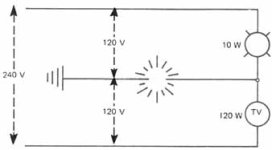Be real carefull of those chinese cra*shoot units. During our last 5 day power outage, i went on 3 calls to look at issues with portable gens powering house panels. All 3 had professional installed transfer switches to lock out mains. The issue with all 3 was i would get 240 with meter hooked to the gens 30 amp outlets, but if you apply the house loads to generator suddenly id get voltages like 207 volts on one leg and 33 volts on other. Not really sure what causes this in generator, but they fried lots of tv, refers, freezers snd gas furnace fans.
All 3 were different off brands, and all three were chinese units. I heard from a local electronics shop that last year was his best year ever repairing circuit boards.....he loves power outages and portable gens.
You could just go around those houses and turn off loads on phase L1 or turn on loads on phase L2 until the load through each phase was equal (120V + 120V= 240V)

You service generators?
There's nothing magical about Chinese generators. So, what causes this:
Hint #1: The 207V in one leg and 33 volts in the other leg shows the generator is putting out (207V + 33V=) 240 Volts just like it's suppose to.
Hint #2: If you measured the voltage across the busses L1 & L2 (or the output of double pole breakers) in those panels, they would still read 240V. But, you measured the 207V between L1
and neutral (or maybe ground), and 33V between L2
and neutral....hmmm... getting closer....
Basically: If you think of the generator as having a 240V winding ( or 2- 120V windings connected in series), the center point of these windings has to be "neutral" (i.e. connected (locked down) to O volts, the earth,) Usually this means bonding the winding's center tap neutral connection with the ground, or using a 4 prong connection so that this neutral-ground bond, which also exists in the service panelboard, is used; so that the 240volts produced by the generator is forced to divide evenly (120V + 120V) across these two equal windings.
Without the neutral connection dividing the 240V equally and "locking in" 120V
to neutral in each leg, the panelboard consists of all the turned on "120V" loads on panel phase L1 being connected
in series with all the turned on phase L2 loads; and 240V being supplied to this circuit.
You have a "floating neutral" situation.
Here's a decent illustration that shows a broken neutral connection (in reality, there's many more loads in parallel with each other on phase L1, and many more loads parallel with each other on L2). Also imagine the generator's windings where they show "120V" or "240" source.
The important point is that without a neutral connection to the source locking in 120V in each leg and providing a return path for single phase currents (for 120V loads) to return to the opposite side of the 120V winding: there's 240V being split across the 10 watt light and the 120 watt tv that are now
in series with each other without a neutral. The 240V will not divide evenly into 120V and 120V across the unbalanced loads.

